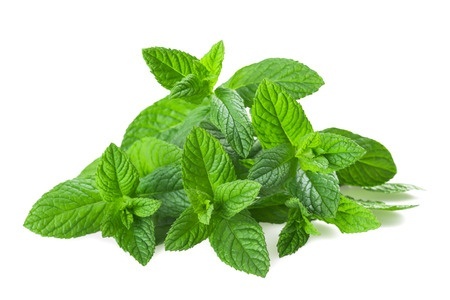
Peppermint (Mentha x piperita L.), of all the many mints has one of the strongest tastes with a powerful soothing effect. It appeared relatively recently as a hybrid of different mint species, but it was only known as ‘Mint’ up to the late 17th Century. In Greek mythology, Menthe was a beautiful nymph with whom Pluto fell in love. His jealous wife Persephone consequently turned Menthe into this plant with this incredibly pleasant aroma !
The leaves and the oil which we focus on here is especially useful on the own in both food and cosmetic products. The oil in particular has value for a number of reasons which we describe below. One of the main compounds in peppermint oil is menthol. It is often described as a form of ‘Mint’ and has been used as a stomach soother following supper since ancient times.
The oil is usually extracted by steam distillation of the leaves although the whole plant is often used. It is a pale yellow or green liquid with a strong minty, pungent and camphorous aroma.
Commercially, the plant is grown throughout northern Europe and central Asia.
Compounds And Componentry
The oil contains menthol (29 to 50 percent), menthone (20 to 34 percent), menthyl acetate, menthofurna, limonene, pulegone, cineol.
Uses
- Some European studies have suggested that menthol in both leaf and oil soothes the stomach lining and possibly prevent stomach ulcers by stimulating the secretion of bile. It helps boost the digestive system as a result and this is one of the main reasons why it has been in common use.
- The oil rubbed on the forehead helps to ease migraines and headaches.
- The oil is also used to ‘stimulate the mind’, increase mental agility and improve focus.
- When applied to the skin, the oil reduces redness and has a calming effect relieving itches and irritations. Peppermint oil can also be applied directly to a minor wound or burn.
- Peppermint oil is used in many pain-relieving skin creams, hinting at its power as an anaesthetic.
- Menthol vapours have been applied as a decongestant for centuries and are used in a variety of rubs and treatments for the common cold. The oil alone is used to relieve sinus and chest congestion too.
- Add to the bath by placing 5 to 8 drops of the oil in a carrier oil like almond oil.
- Massage: a fine oil where 2 or 3 drops of peppermint oil is added to 3 tablespoons of a carrier oil like almond oil.
- For vaporization: add 2 to 4 drops of peppermint oil in 2 tablespoons of water to an oil burner. Please follow the manufacturer’s instructions if the water levels are different.
- The oil is a mouse deterrent. Apparently, mice find the oil especially unpleasant.
How To Prepare
The oil can be applied directly to the skin but not be consumed on its own !
Enjoy as an infusion for cold relief or as a digestive aid by adding one to two teaspoons of dried herb to a cup of hot water and steeping for ten minutes. This can be enjoyed up to three times per day. Spearmint is generally a bit sweeter and less ‘minty’ than Peppermint although the latter creates a cool feeling in the mouth.
Add a few fresh leaves or dried leaves to a cloth bag and hang under bath water for a decongestant effect.
Availability And Products
Peppermint oil
Please note this article contains links to our affiliate marketing partner. Please read our affiliate disclosure.
Purchase your peppermint oil products here
Cautions
- Always avoid pure Menthol or pure Peppermint Oil which are both toxic.
- Keep away from the eyes.
- Do not give to any child under two years old.
- Do not use while pregnant or nursing.
- For over 65s, use low levels and infrequently.
- Do not use the undiluted oil directly on the skin. Must be diluted in a suitable base or carrier oil.
Legal Disclaimer Concerning Products On This Web-Site
The products and the information provided about specific products on or through this site have not been evaluated by the United States Food and Drug Administration or by any other national regulatory body and are not intended to diagnose, treat, cure or prevent disease. The information provided on this site is for informational purposes only and is not intended as a substitute for advice from your physician/doctor or other health care professional or any information contained on or in any product label or packaging. You should not use the information on this site for diagnosis or treatment of any health problems or for prescription of any medication or other treatment. You should consult with a healthcare professional before starting any diet, exercise or supplementation program, before taking any medication or if you suspect you might have a health problem.


Leave a Reply